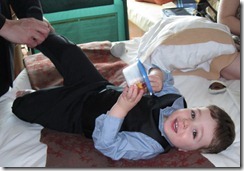I read recently that a substantial percentage of Canadian Boomers expect to continue working for pay after the “normal” retirement age of 65. In doing this, they expect to supplement their retirement income, stay in good health and satisfy their social needs while avoiding boredom. I’m wondering if this magical post retirement life they envision for themselves is largely a mythical one. A Magical Mythical Tour perhaps?
I admit to some prejudice in this matter because I retired early at the tender age of 58. After a two year volunteer “job” in Almonte (doing some of the things I used to get paid for for free) I hung up my food technologist’s hat for good. After nearly 5 years of full time retirement I am certainly not anxious to work again – even part time.
Let’s have a look at some of the working post-retirement myths as I have experienced them at least.
You Can Work At Your Old Job Part Time
Well maybe. I have to admit that when I first brought up the topic of retirement, part time work was suggested by my employer as a means of helping them adjust to my leaving. However, I did not accept for two reasons – first because I’d still be doing the same stressful stuff, and second working “half time” meant 50% of the salary for 75% of the hours. The company would have wanted me to be there half the day or more 5 days a week, to suit their convenience. They weren’t about to cancel meetings on Friday or Monday because I didn’t want to come in to work those days. And I know of at least one half time person who was terminated because she didn’t want to return full time.
You Can Find a New and Fulfilling Part Time Job
I did the two year part time volunteer job in Almonte and I’m sure I could have been paid minimum wage to do it. The small company I worked for really couldn’t have afforded me otherwise. It was fun helping them get Organic Certification but at other times I ended up working in Production a couple of days a week to help out. Finally I just decided it was better to retire full time.
You’ll Be In Better Health If You Keep on Working
I don’t think so. How can you be in better health if you are stressed out with a daily commute, lots of meetings and arbitrary deadlines set by people who aren’t doing the work? I’ve seen some stats that show that the earlier you retire, the longer you’re going to live. I know I’ve been far less depressed as a retiree.
You Need the Social Contacts of the Workplace
I’ve been fine without them thanks. I don’t think it’s healthy to depend on those you work with to give you a rich social life. I still get out to coffee with the boys, and I have the time now to meet and greet whomever I like.
You Must Work to Stave Off Boredom
I wonder if the person who wrote this has ever been retired. In my retirement years I’ve learned a new computer operating system, fixed dozens of computers for people in the neighborhood, traveled extensively in the offseason, hung out with my grandkids. I have time to blog, read all the books I want, moderate an Internet forum. Working was far more boring than retirement – unless you find writing reports, filling out forms, going to meetings and sitting in a traffic jam an antidote for boredom.
Forgive me for saying this, but I wonder if all the lip service paid to working after 65 isn’t just an excuse for the fact that people haven’t planned well enough financially to do anything else but work. Just my $0.02.





